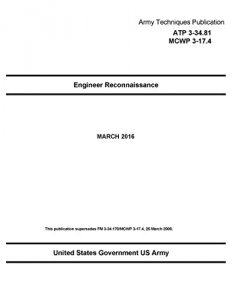ATP 3-34.81 provides techniques for the performance of tactical and technical engineer reconnaissance in support of military activities that are conducted across the full range of military operations. This publication supports doctrine found in ADP 3-0, FM 3-34, ADRP 5-0, and ADRP 6-0.
Although primarily oriented on the brigade combat team (BCT)/regimental combat team (RCT) based Marine air-ground task force (MAGTF) and below, the principal audience for ATP 3-34.81 is all members of the profession of arms. Commanders and staffs of Army and Marine Corps headquarters serving as joint task force or multinational headquarters should also refer to applicable joint or multinational doctrine concerning the range of military operations and joint or multinational forces. Trainers and educators throughout the Army and Marine Corps will also use this publication.
The three engineer disciplines are combat (with the capabilities and activities of mobility, countermobility, and survivability [M/CM/S]), general, and geospatial engineering. These disciplines include significant reconnaissance capabilities. The three engineer disciplines include extensive discussion on integrating the planning for, and conduct of, engineer reconnaissance support within the tactical operations of the combined arms team. This publication discusses the capability resident within combat engineer units to form and employ engineer reconnaissance teams (ERTs). It also describes the capability resident within general engineer elements to form and employ ERTs, augment combat engineer ERTs, or provide assessment and survey teams. Finally, geospatial engineering enables reconnaissance and may play a large role, especially during the planning process.
Engineer reconnaissance, like chemical, biological, radiological, and nuclear (CBRN) and other technical applications, is not a form of reconnaissance. Engineer reconnaissance is a focused application of special or unique capabilities supporting reconnaissance, and it is applicable to all forms of reconnaissance. The engineer disciplines provide reconnaissance capabilities that vary in linkages to warfighting functions, degrees of technical expertise, and effort applied to the assigned mission and tasks. Engineer reconnaissance is directly linked to geospatial intelligence because combat and general engineer units use technical measuring or survey devices to confirm, correct, or update the accuracy of available geospatial information. After analysis and comparison against other intelligence collections, this updated geospatial information becomes intelligence, which feeds the commander’s decisionmaking process.
Finally, this publication is written with the acknowledgement that the operational environment is more variable now. Engineers must be prepared to go into any operational environment and perform a full range of reconnaissance tasks in support of the maneuver commander while dealing with a wide range of threats and other influences. It builds on the collective knowledge and experience gained through nearly a dozen years of sustained military operations and exercises. It is rooted in time-tested principles and fundamentals, while accommodating new technologies and diverse threats to national security.
This publication consists of five chapters and six appendixes that discuss the integration of engineer reconnaissance within the operational planning, execution, and assessment process that is presented in ADRP 5-0, ADRP 6-0, and MCWP 5-1.
Although primarily oriented on the brigade combat team (BCT)/regimental combat team (RCT) based Marine air-ground task force (MAGTF) and below, the principal audience for ATP 3-34.81 is all members of the profession of arms. Commanders and staffs of Army and Marine Corps headquarters serving as joint task force or multinational headquarters should also refer to applicable joint or multinational doctrine concerning the range of military operations and joint or multinational forces. Trainers and educators throughout the Army and Marine Corps will also use this publication.
The three engineer disciplines are combat (with the capabilities and activities of mobility, countermobility, and survivability [M/CM/S]), general, and geospatial engineering. These disciplines include significant reconnaissance capabilities. The three engineer disciplines include extensive discussion on integrating the planning for, and conduct of, engineer reconnaissance support within the tactical operations of the combined arms team. This publication discusses the capability resident within combat engineer units to form and employ engineer reconnaissance teams (ERTs). It also describes the capability resident within general engineer elements to form and employ ERTs, augment combat engineer ERTs, or provide assessment and survey teams. Finally, geospatial engineering enables reconnaissance and may play a large role, especially during the planning process.
Engineer reconnaissance, like chemical, biological, radiological, and nuclear (CBRN) and other technical applications, is not a form of reconnaissance. Engineer reconnaissance is a focused application of special or unique capabilities supporting reconnaissance, and it is applicable to all forms of reconnaissance. The engineer disciplines provide reconnaissance capabilities that vary in linkages to warfighting functions, degrees of technical expertise, and effort applied to the assigned mission and tasks. Engineer reconnaissance is directly linked to geospatial intelligence because combat and general engineer units use technical measuring or survey devices to confirm, correct, or update the accuracy of available geospatial information. After analysis and comparison against other intelligence collections, this updated geospatial information becomes intelligence, which feeds the commander’s decisionmaking process.
Finally, this publication is written with the acknowledgement that the operational environment is more variable now. Engineers must be prepared to go into any operational environment and perform a full range of reconnaissance tasks in support of the maneuver commander while dealing with a wide range of threats and other influences. It builds on the collective knowledge and experience gained through nearly a dozen years of sustained military operations and exercises. It is rooted in time-tested principles and fundamentals, while accommodating new technologies and diverse threats to national security.
This publication consists of five chapters and six appendixes that discuss the integration of engineer reconnaissance within the operational planning, execution, and assessment process that is presented in ADRP 5-0, ADRP 6-0, and MCWP 5-1.



